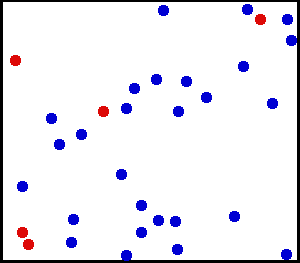Mean Free Path Calculator
This mean free path calculator will help you calculate the mean free path of a particle with the specific diameter in an ideal gas.
An ideal gas consists of a large number of particles (atoms or molecules) that are in constant rapid motion and can collide with each other. During these perfectly elastic collisions, particles can change their directions or energies. The mean free path is the average distance that a particle travels in a material medium between successive collisions with particles of that medium. The term "mean free path" is used in many areas of physics.
Do you want to learn how to calculate the mean free path? In the following text, you will find a more detailed definition of the mean free path and the mean free path formula. Use our calculator to estimate the average distance between particles' collisions of every ideal gas you want. All you need is to provide the ideal gas parameters (pressure and temperature) and an effective particle diameter to the mean free path equation. At the end of this text, you can find a table with the atomic radii of some elements.
If you want to analyze the properties of real gases, don't hesitate and check out our van der Waals equation calculator!
Mean free path definition
In gases, particles have full freedom of movement – there are no chemical bonds between them. All of them are in constant motion in the space occupied by the gas and never stop in one place. There are virtually no long-range interactions between molecules, and the existing ones are very weak. The only way particles can interact is by colliding with each other.
Moreover, if the gas is placed in a container, its particles constantly collide with the walls of the container, exerting a specific and constant pressure on them.
Have you ever wondered how fast do particles move in gases? Check it out using our particle velocity calculator!

Look at the above animation and focus on one specific particle. How far does it travel without any collision? The answer will always be different because of those particles' chaotic motion. Nevertheless, we can calculate the average distance traveled by a moving particle. We call it the mean free path, and it is often used in:
-
Radiography to measure the thickness of a piece of material;
-
Particle physics to measure the magnitude of the interactions of the high-energy photons with a material (radiation length);
-
Electronics to describe the electrical mobility (see drift velocity calculator);
-
Diffusion and transport phenomena, for example, to determine the Knudsen number, which helps to decide whether we can use statistical mechanics or the continuum mechanics (see knudsen number calculator); and also
-
Nuclear physics, optics, astronomy or acoustics.
💡 Normally, the term molecule refers to two or more atoms. However, in the field of the kinetic theory of gases, "molecule" can refer to a single atom in its gaseous state. For example, helium, neon, argon, and the other noble gases.
How to calculate mean free path? - mean free path equation
You can easily calculate the mean free path of particles of a gas, provided that this gas can be described with the ideal gas law equation. Our mean free path calculator uses the below mean free path equation:
where:
- – Mean free path expressed in the length units;
- – Temperature of the gas;
- – Pressure of the gas;
- – Kinetic diameter of a particle; and
- – Boltzmann constant .
In fact, the diameter of a particle is not well-defined because gas particles do not behave like hard spheres. We use only the effective diameter of the atom, which is the minimum distance at which two particles of the same gas are approaching each other during a collision. In other words, it is the distance between the centers of these particles at the moment of collision.
The mean free path of gas molecules is often used to measure the quality of the vacuum. For example, the mean free path of air particles at room temperature and an atmospheric pressure of 1013 hPa is 68 nm. However, if we decrease pressure to high vacuum ~10-5 Pa, the mean free path is approximately 1 km.
Mean free path formula – kinetic radii table
Our mean free path formula requires kinetic diameter to perform proper calculations. You can find both radii and diameters (two times the radius) of the molecules of some gases in the below table (expressed in picometers – pm), which we created based on the on Wikipedia.
Molecule | Radius (pm) | Diameter (pm) |
|---|---|---|
Hydrogen (H₂) | 144.5 | 289 |
Helium (He) | 130 | 260 |
Nitrogen (N₂) | 182 | 364 |
Oxygen (O₂) | 173 | 346 |
Neon (Ne) | 137.5 | 275 |
Chlorine (Cl) | 160 | 320 |
Argon (Ar) | 170 | 340 |
Bromine (Br) | 175 | 350 |
Krypton (Kr) | 180 | 360 |
Xenon (Xe) | 198 | 396 |
Water (H₂O) | 132.5 | 265 |
Carbon monoxide (CO) | 188 | 376 |
Carbon dioxide (CO₂) | 165 | 330 |
Nitric oxide (NO) | 158.5 | 317 |
Nitrous oxide (N₂O) | 165 | 330 |
Sulfur dioxide (SO₂) | 180 | 360 |
Hydrogen sulfide (H₂S) | 180 | 360 |
Hydrogen chloride (HCl) | 160 | 320 |
Hydrogen bromide (HBr) | 175 | 350 |
Ammonia (NH₃) | 130 | 260 |
Sulfur hexafluoride (SF₆) | 275 | 550 |
Carbon tetrachloride (CCl₄) | 295 | 590 |
Methane (CH₄) | 190 | 380 |
Acetylene (C₂H₂) | 165 | 330 |
Ethylene (C₂H₄) | 195 | 390 |
Propylene (C₃H₆) | 225 | 450 |
Propane (C₃H₈) | 215 | 430 |
Benzene (C₆H₆) | 292.5 | 585 |